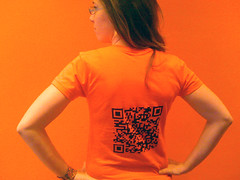I woke up to the BUZZ, this morning, Google’s new social networking tool. The first person I saw was Sharon Peters (other than Brenda, elbowing me about my phone making some noise in my office). What impresses me about BUZZ is how well it integrates into the rest of the Google community of apps, making it almost unavoidable. But my mind keeps telling me…
 |
 |
|
Barcode of my Name |
QR Code of my web site |
I spent most of yesterday afternoon tinkering with matrix codes, which are two-dimensional scan codes — as opposed to the single-dimensional bar codes (see right). I was especially interested in QR Codes with which you can express a wide range of information, to be picked up by scanners. QRStuff includes an online tool that will generate printable codes that hold: text, website URLs, a telephone number, SMS message, contact details (VCARD), Google map location, or Facebook and MySpace profiles. Then, you can have QRStuff print it on a T-shirt for you for only $19.95.
 |
 |
What makes these things so potentially useful is the wild range of smartphone apps that will scan these things with the phone’s camera. So I might walk up to a restaurant, with a matrix code by the door, scan it with my iPhone, and receive the establishment’s web page with menu, reviews, and dress code. Or, I might include one at the opening of my presentation Prezi™, that the audience might scan with their smartphones to load my online handouts or backchannel site — heads up you guys in Brevard County, Florida.
I also see this being played in some geospacial mystery or scavenger hunt-style games, which may be the potential of Kaywa‘s DokoDar. But beyond that, I can only feel that there might be other ways that this sort of real/digital life connectivity might be used.
If I had a classroom, I’d ask my students?
What do you think? What do your students think?
Powered by ScribeFire.


You can access the QR generator for free at http://qrcode.kaywa.com/
Free = Great for school application!
It’s tech, and it’s free, and that’s good. But what’s the pedagogical application. It’s interesting to have a way to send students to specific web resources and to send content to their phones or computers via the codes. But isn’t that what Moodle’s for?
It seems to me that the punch of this stuff is geospacial. That you can stick a matrix code stamp someplace in town, or on the campus of the school, and embed content — or a clue, within it. There you go. An ARG, where the student body participates in a campus- (or town-) wide plot, that with curriculum embedded.
Dave, this is VERY interesting. Have you looked at the i-nigma software for SmartPhones? It looks like a pretty cool way to share information.
I think this could lead to a revolution in the world languages community. Why wouldn’t a restaurant include a QR code that would show the menu in a different language? Same could be done with almost anything in print. Combine that with apps like Jibbigo which will give automatic (and almost instantaneous) voice translation from one spoken language to another and the stage is set. May not be ready for primetime today, but . . .
I can see down the road when you could put on a pair of glasses that will do just about the same thing — look and you will see your language of choice displayed on top of the original language. Have seen prototypes of that using AR.
I think a whole new world language teaching opportunity emerges.
I follow your blog using RSS feed in my Apple Mail application. While reading this article, I used my BlackBerry Tour to scan your QR Code and the browser launched linking to your web site on my phone. Does it get any better than this?
Matrix codes (commonly called QR Codes) have been used in Japan for years. I see them on Japanese business cards a lot.
Here is an excerpt from a 2007 article:
http://www.japanmarketingnews.com/2007/01/in_previous_art.html
“Movie studios make it easy to view coming attractions by printing QR codes on posters that are hung all over Japan. Scan the code and voilà—you’re watching previews of films right on your phone. Fast food brands are now printing these codes on sandwich wrappers (nutritional and/or ingredient information). Retailers print them on receipts. Event producers employ them to provide exhibit information. Doctor’s offices and beauty salons use them to let people make appointments over their mobile phones. Companies print them on business cards so clients and suppliers can suck contact info right into their cell phones and PDAs.”